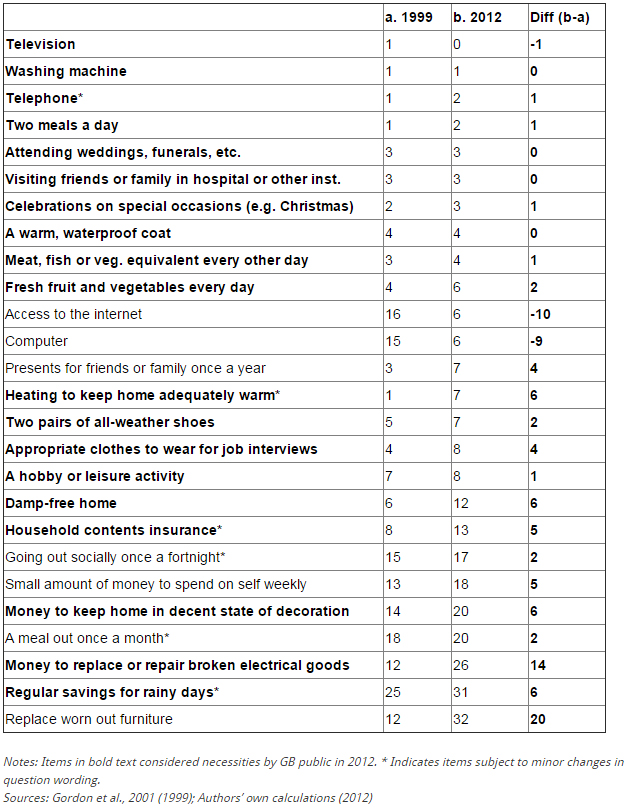
Tessa Coombes, PhD student in the School for Policy Studies, former councillor, ex-policy director at Business West, and part-time blogger considers the latest debates in poverty measurement as illustrated in an event organised by the Centre for Poverty and Social Justice
There’s an interesting debate that’s been going on for some time now about measuring poverty and getting the issue onto the agenda so people sit up and take notice in the right way. It’s an area of academia that I haven’t really engaged in before, but one where I have a personal interest in seeking to see the debate move in the right kind of direction. A direction that takes us away from the concept of demonising the poor and those living in poverty and instead acknowledges the levels of inequality and seeks to do something about it in a way that benefits those most in need. The recent Policy & Politics conference in Bristol had inequality and poverty as one of its main themes and at the time I wrote a couple of blogs on the plenary sessions – the human cost of inequality (Kate Pickett) and why social inequality persists (Danny Dorling). Both these presentations provided plenty of evidence to illustrate just how significant a problem we have in the UK and how it is getting worse.
Last week I went to a seminar on this very issue run by the Centre for the Study of Poverty and Social Justice at the University of Bristol, where the subject of debate was about how to gain traction and create change from academic research and evidence. The focus of the discussion was about using living standards rather than poverty indicators and the difference this can make when trying to attract the attention of politicians and policy makers. It was an interesting and thought provoking debate which gave some pointers on how we can translate measures and indicators into policy and action, as well as why it’s helpful to look at living standards for everyone rather than just looking at those in poverty.
The first speaker, Bryan Perry from the Ministry of Social Development in New Zealand, talked about how by using evidence in the ‘right’ way, that was responsive to the needs of politicians, using the Material Wellbeing Index, they had managed to gain traction and make an impact on policy. The key was talking about trends rather than absolute numbers, providing simple statistics that tell the ‘right’ story and making the most of the opportunities as they arise. The focus of their work on living standards has served to highlight the differences, to show how life at the bottom is radically different, and to emphasise the point, in simple terms, about what people don’t have rather than about what they need. This has resulted in a centre-right government actually implementing increases in benefit payments as part of their policy, rather than seeking to reduce them at every opportunity.
The discussion then turned to the UK with a presentation from Demi Patsios, on the development of a UK Living Standards Index (UKLSI), where the point was made that in order to understand the poor we need to understand the rich, therefore just looking at those in poverty is only a small part of the story we need to capture. The ability to understand poverty in the general context of society provides that broader picture and story, which serves to highlight the extent and levels of inequality, rather than just the hardships at one end of the spectrum and enables us to develop policies that are directed at the full spectrum of society. The UKLSI aims to measure what matters most to people under three main themes: what we have, what we do and where we live. Whilst it is much more complicated that this and brings together both objective and subjective data into 10 domains and 275 different measures, the overall concept and themes are simple to understand and highlight some important differences and issues. The Index helps us to understand ‘what we have’ by looking at essential v desirables and luxuries v wants. It looks at ‘what we do’ through political, social and community engagement and ‘where we live’ by satisfaction with our accommodation and neighbourhood. It brings together the types of measures that appear in things like the Living Wage calculations and local authority Quality of Life indicators, and it does it in a comprehensive and compelling fashion.
But what does all this add to the debate and will our politicians take any notice? How do we make this type of discussion gain traction in the UK, in the face of current media and government interest in individualising the problem and stigmatising the poor, whilst ensuring the poverty discourse is firmly focused away from the rich and powerful?
The current government’s approach, as outlined by Dave Gordon in his presentation, is to repeal the only legislation we had with real targets to reduce poverty (the Child Poverty Act) and to replace this with measures on educational attainment and workless households. It’ll certainly be interesting to see how this approach can work with the recent commitment under the new United Nations Sustainable Development Goals to “end poverty in all its forms everywhere” and to “reduce inequality within and among countries”.
From my own experience, as an ex-politician and someone who has worked with politicians and policy makers over many years, the key for me is making the messages simple. Yes, providing the evidence to support the simple statements, but only after you’ve sold them the message to begin with. Overcomplicating things with lots of measures and targets just serves to mask the message and hide the key points. Something that combines simple messages with supporting evidence; that illustrates disparities in living standards; and provides for micro level analysis would seem to be the right kind of approach.
This blog was first posted on Tessa’s own blog





